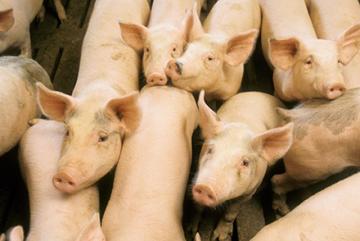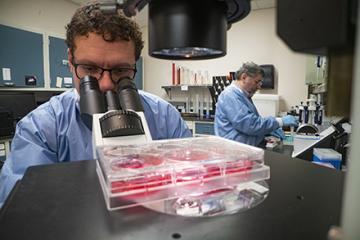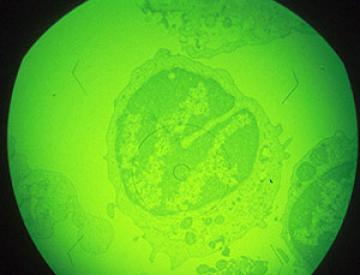Expanding on the Legacy of the Plum Island Animal Disease Center

ARS discoveries are providing vital information to help fight this economically devastating disease, which affects cattle and other cloven-hoofed animals. (Regis Lefebure, K5657-3)
Since 1954, USDA scientists at the Plum Island Animal Disease Center in Orient Point, NY, have been helping other countries in a united front against foreign animal diseases. These efforts also help the U.S. prepare for and prevent a potential introduction of a high-consequence livestock disease.
African swine fever virus, or ASFV, is among the most concerning animal disease pathogens currently circulating the globe, according to Dr. Douglas Gladue and Dr. Manuel Borca, two USDA Agricultural Research Service scientists studying ASFV.
“Currently African Swine Fever is causing a pandemic, with most of the outbreaks taking place in Europe and Asia,” Gladue said. “However, it has also been a historical problem in Africa for many years, where the disease is endemic in many sub-Saharan countries.”
While the pathogen doesn’t affect humans and has not been seen in U.S. swine, it is economically affecting the pork industry. The disease’s effect in Asia has cost the continent from $55 billion to $130 billion, according to a publication in Asian Development Bank.

At the Plum Island Animal Disease Center, ARS microbiologists Douglas Gladue (left) and Manuel Borca work on developing candidate vaccines against African swine fever virus. (Lance Cheung, D4569-1)
Early detection and culling of infected animals have helped to reduce disease spread while scientists work to develop an effective vaccine.
In Plum Island’s safe and secure biosafety level 3, or BSL-3, laboratory, Gladue and Borca were able to delete a gene from a highly-infectious strain of ASFV to weaken the virus and make a vaccine. They also were able to adapt the vaccine to grow in a cell culture, which makes it more practical for commercial production at a larger scale.
“Having the adequate animal facilities at this biosafety level to perform vaccine challenge studies is critical to test experimental vaccines,” Borca said.
USDA scientists like Borca and Gladue will soon have the opportunity to continue and expand on science established at Plum Island through a next-generation laboratory facility in Manhattan, KS, the National Bio and Agro-Defense Facility, or NBAF.

Macrophage cell in early stages of infection with African swine fever virus, magnified about 1,000x. (Keith Weller, K7335-17)
“As USDA scientists from Plum Island’s Foreign Animal Disease Research Unit prepare to move west, NBAF offers opportunities for them to build on these successes,” said NBAF Director Dr. Alfonso Clavijo. “We greatly value these experiences as work in African swine fever and foot and mouth disease will continue at NBAF. The added capabilities at NBAF, which include state-of-the-art equipment and animal holding facilities, will enhance their research capabilities.”
Borca and Gladue’s work has led to a cooperative agreement with a Vietnamese company to help produce their vaccine. On the western edge of the nation’s highest concentration of animal health companies, NBAF’s new and unique capabilities will support growth in corporate partnerships like these.
“The Biologics Development Module will accelerate the veterinary countermeasure products and discoveries of the Foreign Animal Disease Research Unit to the pharmaceutical industry,” Clavijo said. “This provides agile transition of research to marketable products, which can address the nation’s critical animal health priorities.”
Through this critical type of science and vital partnerships, USDA can continue to provide veterinarians and ranchers with the tools and services to protect America’s food supply and help the world fight animal diseases. —By Stephanie Jacques, NBAF Office of Communications.

